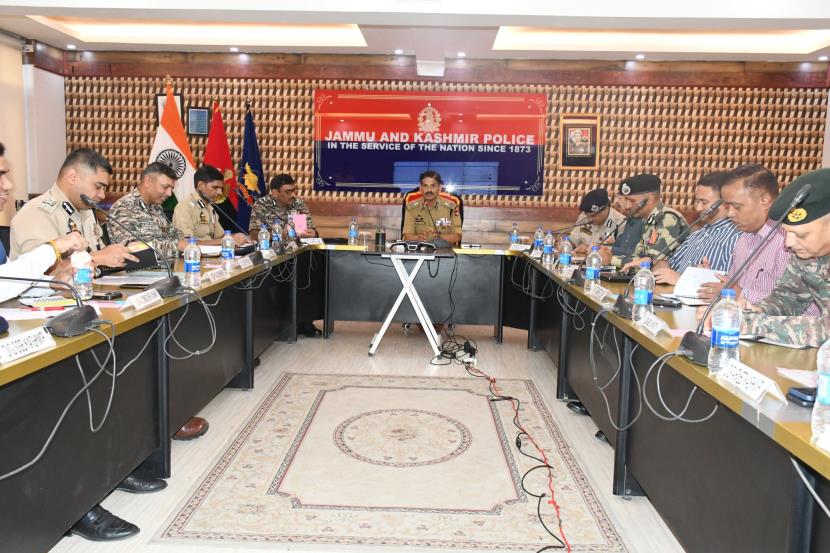SRINAGAR: Director General of Police (DGP) Rashmi Ranjan Swain chaired a crucial high-level security meeting on Tuesday to review the security arrangements for the upcoming Independence Day celebrations across Jammu and Kashmir.
The high-level security meeting was attended by top officers from the civil administration, Police, Army, Central Armed Police Forces (CAPFs), and intelligence agencies.
The meeting was convened to ensure a foolproof security apparatus for the celebrations.
“
SRINAGAR: Director General of Police (DGP) Rashmi Ranjan Swain chaired a crucial high-level security meeting on Tuesday to review the security arrangements for the upcoming Independence Day celebrations across Jammu and Kashmir.
The high-level security meeting was attended by top officers from the civil administration, Police, Army, Central Armed Police Forces (CAPFs), and intelligence agencies.
The meeting was convened to ensure a foolproof security apparatus for the celebrations.
“DGP R R Swain today chaired a high-level security meeting to review security measures for 78th Independence Day celebrations across the J&K. During the meeting threat assessment, countermeasures, surveillance, supervision, intelligence gathering, deployment of personnel, and access control were discussed. Top officers of civil administration, Police, Army, CAPFs, and intelligence agencies took part in the meeting and gave detailed briefings of the preparation on various fronts to the DGP. #IndependenceDay2024,” J&K Police said in a post on X.
The meeting focused on identifying potential threats from various quarters, including terror groups, radicalised elements, and cross-border infiltration attempts.
The DGP emphasised the need for heightened vigilance, particularly in sensitive areas where the risk of violence or sabotage is higher.
To mitigate these risks, a series of countermeasures were discussed.
These include intensified patrolling, quick response teams, and the deployment of additional forces.
The DGP highlighted the importance of coordination between different security agencies to ensure a swift and effective response to any potential threat.
Swain stressed the need for advanced surveillance systems, including the use of drones, CCTV networks, and other technological tools to monitor key locations.
The integration of real-time data from various sources was discussed to enhance situational awareness and enable prompt decision-making.
Supervision of ground-level operations was also a priority.
Senior officers were tasked with overseeing the deployment of personnel and ensuring that all security protocols were strictly followed.
The DGP directed that regular briefings and debriefings be conducted to keep all personnel informed of the latest developments and any emerging threats.
He called for enhanced intelligence gathering, with a particular focus on human intelligence (HUMINT) and signals intelligence (SIGINT).
Collaboration between different intelligence agencies was emphasised to ensure that actionable intelligence is shared promptly and effectively.
The meeting also reviewed the deployment of personnel in Kashmir.
A multi-tier security grid is being put in place, with forces deployed at strategic locations, including government buildings, public spaces, and venues where official celebrations will take place.
The meeting focused on identifying potential threats from various quarters, including terror groups, radicalised elements, and cross-border infiltration attempts.
The DGP emphasised the need for heightened vigilance, particularly in sensitive areas where the risk of violence or sabotage is higher.
To mitigate these risks, a series of countermeasures were discussed.
These include intensified patrolling, quick response teams, and the deployment of additional forces.
The DGP highlighted the importance of coordination between different security agencies to ensure a swift and effective response to any potential threat.
Swain stressed the need for advanced surveillance systems, including the use of drones, CCTV networks, and other technological tools to monitor key locations.
The integration of real-time data from various sources was discussed to enhance situational awareness and enable prompt decision-making.
Supervision of ground-level operations was also a priority.
Senior officers were tasked with overseeing the deployment of personnel and ensuring that all security protocols were strictly followed.
The DGP directed that regular briefings and debriefings be conducted to keep all personnel informed of the latest developments and any emerging threats.
He called for enhanced intelligence gathering, with a particular focus on human intelligence (HUMINT) and signals intelligence (SIGINT).
Collaboration between different intelligence agencies was emphasised to ensure that actionable intelligence is shared promptly and effectively.
The meeting also reviewed the deployment of personnel in Kashmir.
A multi-tier security grid is being put in place, with forces deployed at strategic locations, including government buildings, public spaces, and venues where official celebrations will take place.







